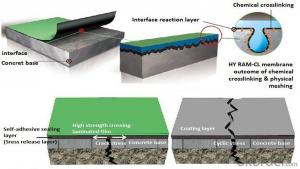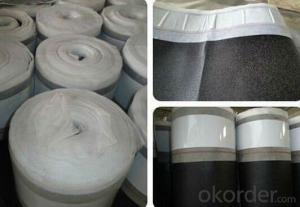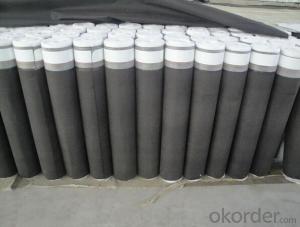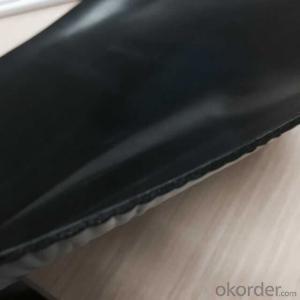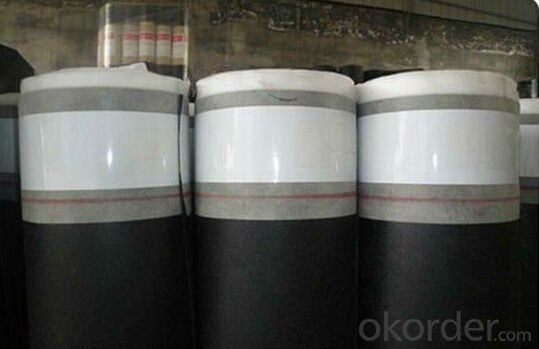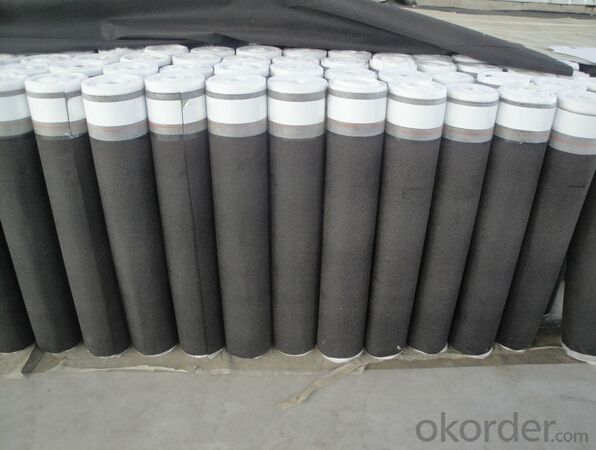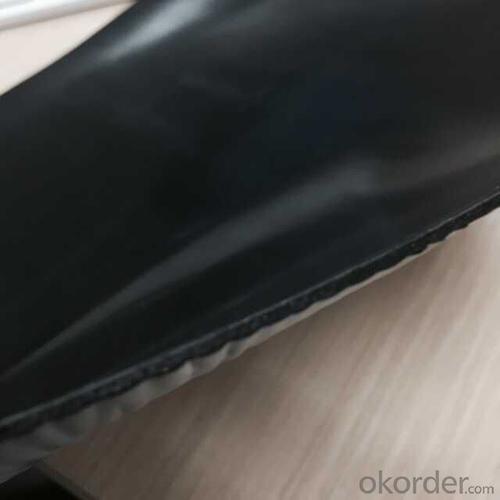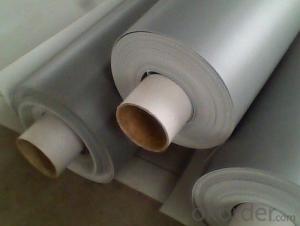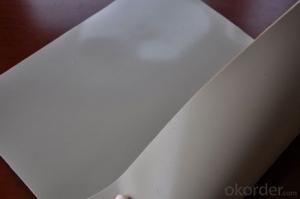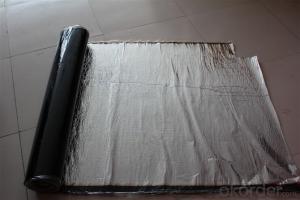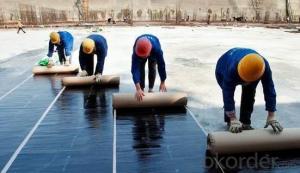Self-adhesive Waterproof Membrane 3mm thickness
- Loading Port:
- Qingdao
- Payment Terms:
- TT OR LC
- Min Order Qty:
- 2000 m²
- Supply Capability:
- 60000000 m²/month
OKorder Service Pledge
OKorder Financial Service
You Might Also Like
Specifications:
Introduction Self-adhesive Waterproof Membrane 3mm thickness :
SBS(Styrene Butadiene Styrene) /APP (Atactic Polypropylene) modified bitumen membrane is made by saturating the base in bitumen, or thermoplastic elastomer (such as SBS, APP, APAO, APO), reinforced with polyester or fiberglass, finishing the upward face with polythene membrane, fine sands or mineral slates (or grains) or etc.
Specification Self-adhesive Waterproof Membrane 3mm thickness :
Thickness | 3mm, 4mm, 5mm |
Width | 1m |
length | 7.5m, 10m, 15m, or on demand |
Base | Polyester or Fiberglass felt |
Surface | PE film, Aluminum foil, Yellow sand, Shale gravel(Schist), colored sand |
Type | could self-adhesive |
Notice | SBS modified bitumen membrane is specially applied in the cold district, APP modified bitumen membrane is more suitable for hot district with high temperature. could be self-adhesive modified bitumen membrane |
Applications Self-adhesive Waterproof Membrane 3mm thickness:
-Roof and underground in industrial and civil buildings;
-Bridge, subway, tunnel, swimming pool, etc.
-Waste landfill, sewage plant, irrigation system, etc.
-Self-adhesive Modified Bitumen Waterproof Membrane
-Easy applying and economic on the cost saving
Advantage Self-adhesive Waterproof Membrane 3mm thickness:
-Non-solidified, excellent elastic deformation,thus have good noise reducing;
-Easy applying and economic on the cost saving.
-Good performance on waterproof and economic sound damping.
Picture Self-adhesive Waterproof Membrane 3mm thickness:
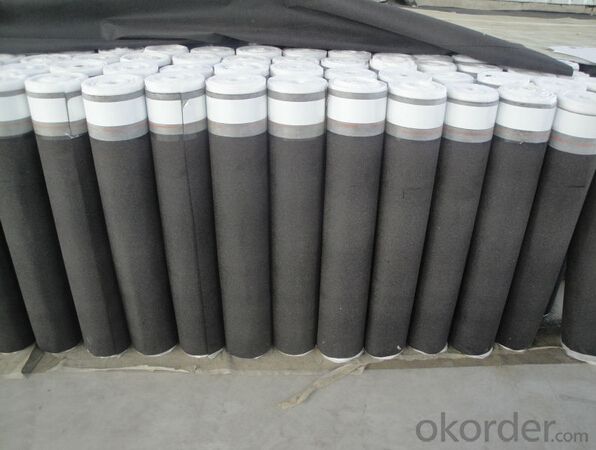
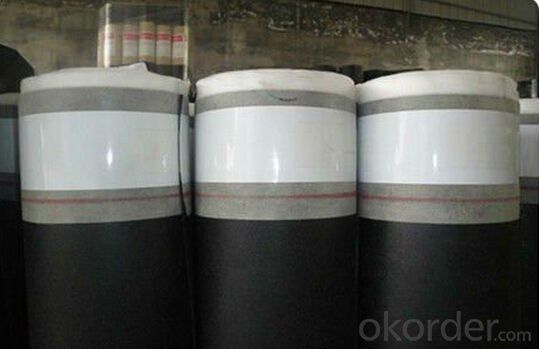
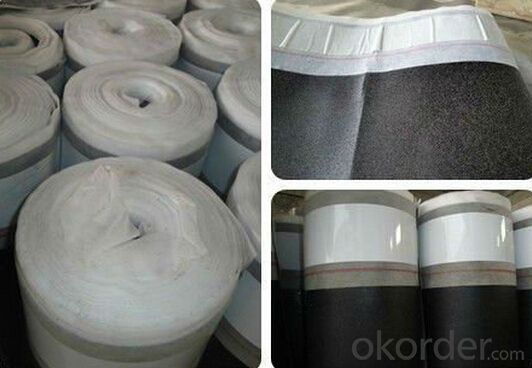
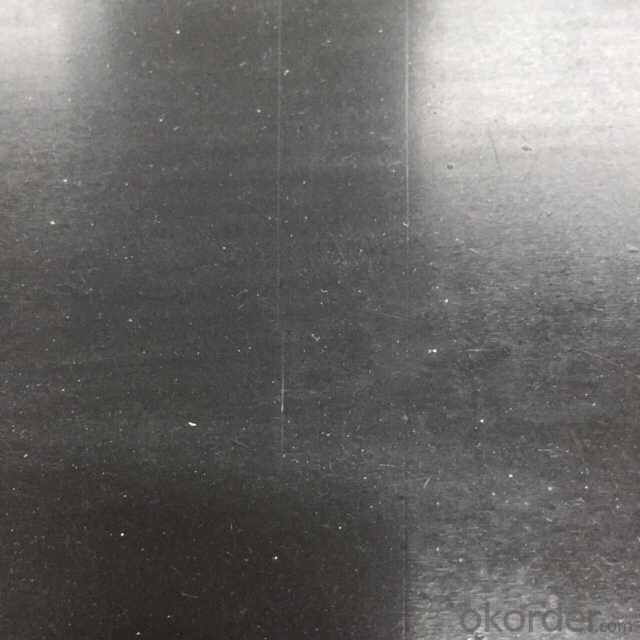
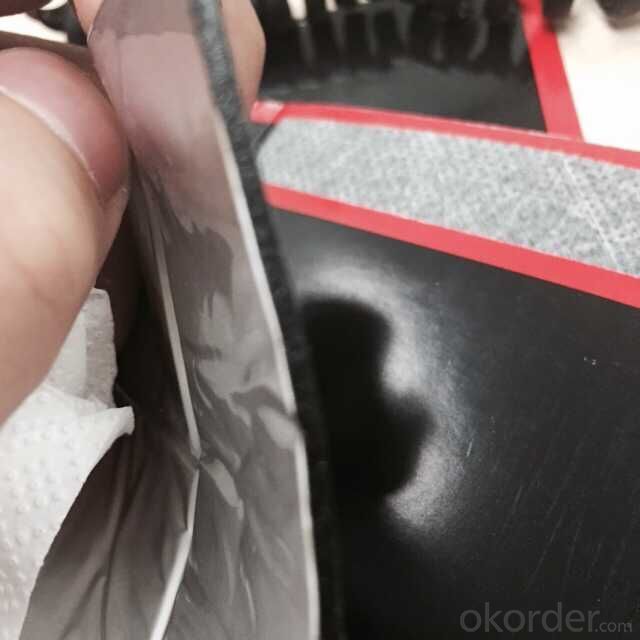
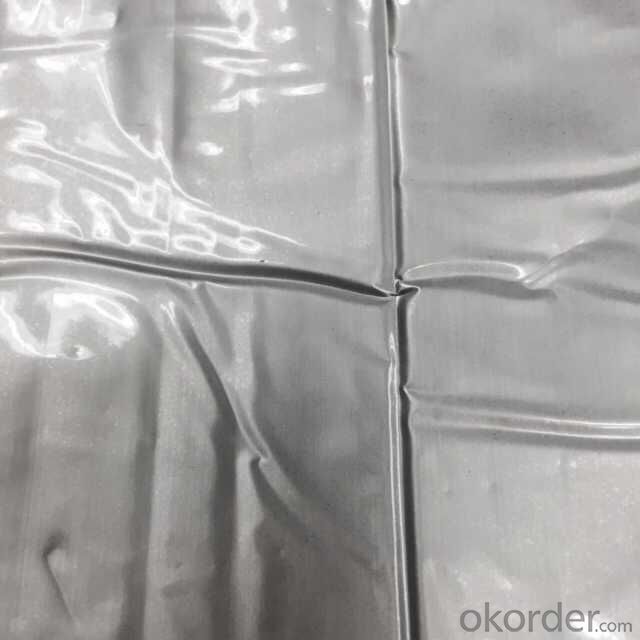


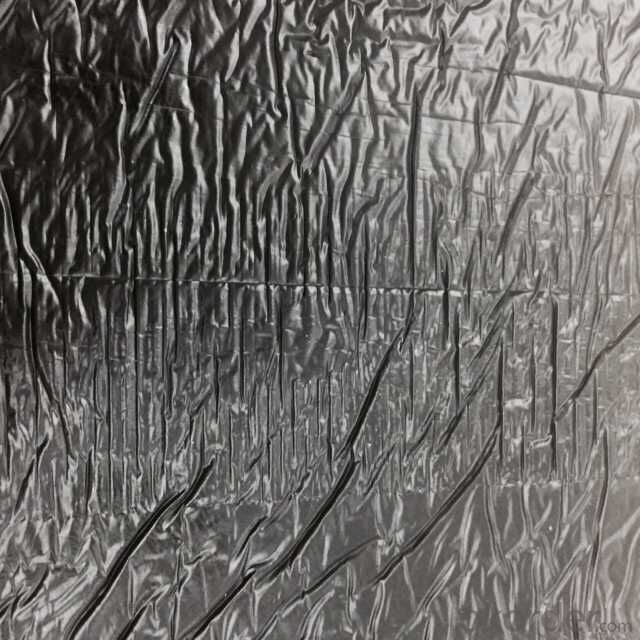
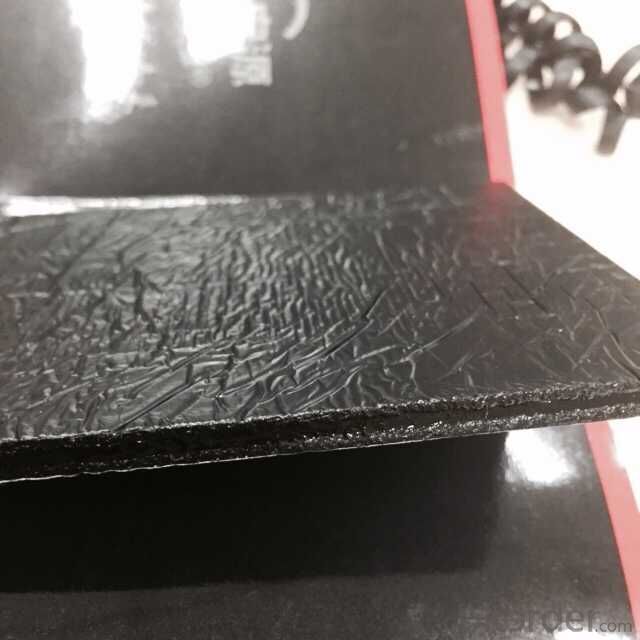
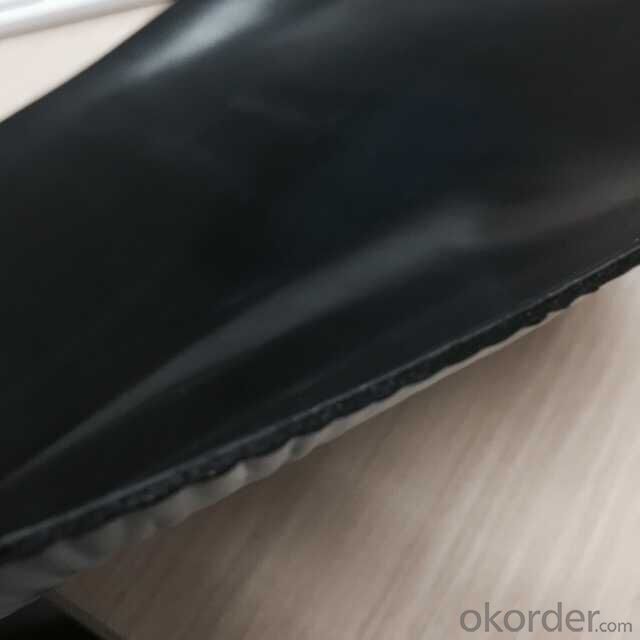
Storage Self-adhesive Waterproof Membrane 3mm thickness:
Shelf life is 12 months. Store in a cool and dry place with original packing.
Breathable Waterproof Roof Underlay membrane (PP-PP,S-PP,S-S)
Permeable membrane is polymer modified asphalt based, with surface of high strength polypropylene fiber. Back side coated with self adhesive glue or antiskid sand. Made by special process. With excellent waterproof performance and breathable properties.\
Description | Specification | Width | Length | Thickness | |
Roof underlay | 500g/m2PP—PP | 1000mm | 30m | 0.8mm | |
600g/m2S—PP | 1000mm | 25m | 1.0mm | ||
1500g/m2S—S | 1000mm | 20m | 1.3mm | ||
Roof underlay with adhesive band | 500g/m2PP—PP | 1000mm | 30m | 0.8mm | |
600g/m2S—PP | 1000mm | 25m | 1.0mm | ||
1500g/m2S—S | 1000mm | 20m | 1.3mm | ||
It is used as the underlayment of cement tile, painted pottery watts and asphalt shingle. Also suitable for all kinds of architectural roofing, walls, underground waterproof and damp proof project.
Features:
It has good waterproofing and ageing-resistance function,not flowing at highest temperature and no crack at lowest temperature;
Easy application,no pollution,and long service life etc.
Usage:
It is widely used for industry and civil building --- the waterproof and dampproof of the roofs,basements,toilets etc;and the waterproofing of bridges,parking area,tunnels,reserviors etc.
It is specially suitable to the building waterproofing in cold area and to the buildings of changeable constructions.
Requirements for surroundings
-The base should be dry and clean. Do not work in the rainy or snowy day.
-Do not work under heavy wind(above 5 grade)
-Unsuitable for construction below 0°C
FAQ:
1. What are we supplying?
We are specialized in producing Colorful Asphalt Roof Shingle, SBS/APP modified bitumen waterproof membrane, Self adhesive bitumen waterproof membrane, PVC waterproofing membrane, EPDM rubber roofing membrane, Single Component Polyurethane Waterproof Coating, and Spray Polyurea Waterproof Coating
2. How Many years experience do we have?
We have been exported to more than 20 countries in the past 15 years.
3. How long do we usually reply your request?
We always reply our customer within 24 hours.
- Q: Can a waterproofing membrane be used for a bridge deck construction?
- Yes, a waterproofing membrane can be used for bridge deck construction. A waterproofing membrane is a thin layer of material that is applied to the bridge deck to prevent water infiltration and protect the underlying structure from corrosion and deterioration. It is commonly used in bridge deck construction to ensure the longevity and durability of the bridge. The waterproofing membrane acts as a barrier against moisture, preventing water and other liquids from penetrating the bridge deck surface. This is particularly important for bridge decks, as they are constantly exposed to various weather conditions, including rain, snow, and ice, which can cause damage over time. In addition to its water resistance properties, a waterproofing membrane also provides protection against other elements such as UV rays and chemicals, which can degrade the bridge deck surface. By preventing water and other harmful substances from reaching the bridge deck, the waterproofing membrane helps to extend the lifespan of the bridge and reduce maintenance and repair costs. Furthermore, a waterproofing membrane can also improve the overall safety of the bridge by reducing the risk of structural damage caused by water infiltration. By keeping the bridge deck dry, the membrane helps to maintain the integrity of the bridge and prevents potential hazards such as slippery surfaces or weakened structural components. Overall, a waterproofing membrane is a crucial component in bridge deck construction as it ensures the long-term functionality and durability of the bridge. Its ability to provide protection against water infiltration, UV rays, and chemicals makes it an ideal choice for enhancing the performance and lifespan of a bridge.
- Q: Can a waterproofing membrane be used for a swimming pool deck?
- Yes, a waterproofing membrane can be used for a swimming pool deck. Waterproofing membranes are designed to provide a barrier against water infiltration, which makes them suitable for protecting the pool deck from water damage and ensuring its longevity.
- Q: Are waterproofing membranes suitable for rooftop gardens?
- Rooftop gardens require proper waterproofing to prevent water leakage and structural damage. Waterproofing membranes, made of materials like rubber, PVC, or modified bitumen, create a barrier to stop water from entering the building. These membranes are highly resistant to water penetration. Without reliable waterproofing, excess water from irrigation or rainfall can damage the building, fostering mold growth and deterioration. Waterproofing membranes effectively seal the rooftop, preventing water infiltration and providing a long-lasting solution. Moreover, waterproofing membranes offer additional benefits. They protect against root penetration, safeguarding the roof structure. They also regulate building temperature by reducing heat absorption, enhancing energy efficiency. It's crucial to hire professionals with expertise in waterproofing systems for membrane selection and installation. They ensure proper installation, defect-free membranes, and integration with other roofing components. In conclusion, waterproofing membranes are suitable for rooftop gardens. They protect against water ingress, root penetration, and structural damage, allowing rooftop gardens to thrive while maintaining the building's integrity and longevity.
- Q: Can waterproofing membranes be used on shower walls?
- Yes, waterproofing membranes can indeed be used on shower walls. In fact, they are an essential component of shower construction to prevent water leakage and potential damage to surrounding areas. Waterproofing membranes create a barrier that prevents water from seeping through the walls and into the structural components of the shower. They are typically installed behind the tile or other wall covering materials to provide an extra layer of protection. Waterproofing membranes are designed to be flexible, durable, and resistant to moisture, ensuring that the shower walls remain watertight and free from any potential water damage.
- Q: Can a waterproofing membrane be used in areas with high levels of moisture and humidity?
- Yes, a waterproofing membrane can be used in areas with high levels of moisture and humidity. Waterproofing membranes are specifically designed to prevent water penetration and can effectively protect surfaces from water damage even in damp and humid environments.
- Q: Is a waterproofing membrane resistant to punctures or tears?
- Yes, a waterproofing membrane is designed to be resistant to punctures or tears. It is typically made from durable materials such as PVC, TPO, or EPDM, which are known for their strength and resistance to damage. These membranes undergo rigorous testing to ensure their ability to withstand various environmental conditions and potential sources of punctures or tears, such as sharp objects or heavy foot traffic. Additionally, some waterproofing membranes come with reinforcement layers or added protection to further enhance their puncture and tear resistance. However, it is important to note that while waterproofing membranes are highly resilient, they are not completely impervious to damage. Proper installation, regular maintenance, and avoiding unnecessary stress or impact on the membrane can help maximize its longevity and performance.
- Q: Can waterproofing membranes be installed on uneven surfaces?
- Yes, waterproofing membranes can be installed on uneven surfaces. However, to ensure effective installation, it is important to properly prepare the surface by leveling or smoothing it out as much as possible before applying the membrane.
- Q: Are waterproofing membranes resistant to hail damage?
- Yes, waterproofing membranes are generally resistant to hail damage. They are designed to withstand various weather conditions, including hailstorms, without getting damaged or compromised.
- Q: Can a waterproofing membrane be used in cold climates?
- Yes, a waterproofing membrane can be used in cold climates. In fact, it is highly recommended to use a waterproofing membrane in cold climates to protect structures from moisture damage caused by snow, ice, and freezing temperatures. Waterproofing membranes are designed to be flexible and durable, allowing them to withstand extreme temperature fluctuations without cracking or deteriorating. They create a barrier that prevents water from seeping into the structure, which is crucial in cold climates where water can freeze and expand, causing significant damage to buildings and infrastructure. Additionally, some waterproofing membranes are specifically formulated to perform well in cold weather conditions, offering enhanced resistance to freeze-thaw cycles and ensuring long-term protection against water infiltration. Therefore, it is essential to use a quality waterproofing membrane in cold climates to maintain the integrity and longevity of structures.
- Q: Can a waterproofing membrane be used for a stadium roof structure?
- Yes, a waterproofing membrane can be used for a stadium roof structure. A waterproofing membrane is a protective layer that prevents water from penetrating the roof and causing damage. It is typically made of materials such as rubber or synthetic polymers that are resistant to water. In the case of a stadium roof structure, a waterproofing membrane can be used to ensure that the roof remains watertight and prevents any leaks or water damage. This is particularly important for stadiums that have open-air or retractable roofs, as they are exposed to the elements and are more susceptible to water infiltration. A waterproofing membrane can be applied to various types of stadium roof structures, including metal, concrete, or even fabric roofs. It is typically installed beneath the roofing material, acting as a protective barrier against water. By preventing water from seeping into the roof, the membrane helps to extend the lifespan of the roof and protect the interior of the stadium from water damage. Additionally, a waterproofing membrane can also provide other benefits for a stadium roof structure. It can help to improve energy efficiency by reducing heat loss or gain through the roof. Some membranes also offer UV resistance, which helps to protect the roof from damaging ultraviolet rays. Overall, using a waterproofing membrane for a stadium roof structure is a practical and effective solution to ensure the roof remains watertight, durable, and protected from water damage.
Send your message to us
Self-adhesive Waterproof Membrane 3mm thickness
- Loading Port:
- Qingdao
- Payment Terms:
- TT OR LC
- Min Order Qty:
- 2000 m²
- Supply Capability:
- 60000000 m²/month
OKorder Service Pledge
OKorder Financial Service
Similar products
Hot products
Hot Searches
Related keywords
